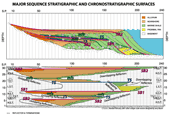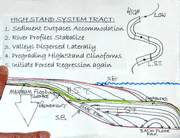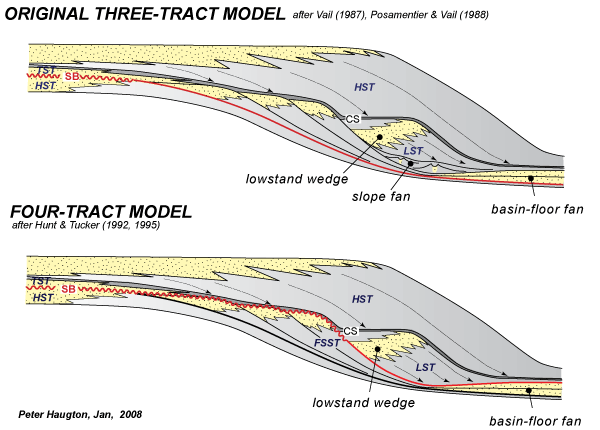|
boundaries
correlative conformity
depositional sequence
eustatic inflection points
First-order cycle
Fourth-order cycle
Fifth-order cycles
genetic sequence
Second-order cycle
Third-order cycle
sequence stratigraphy
sequence stratigraphic models
sequence boundary
surfaces
systems tract
transgressive-regressive sequence (TR)
unconformity




|
A relatively conformable succession of genetically related strata bounded at their upper surface and base by unconformities and their correlative conformities (Vail, et al., 1977). This sequence is composed of a succession of genetically linked deposition systems (systems tracts) and is interpreted to be deposited between eustatic-fall inflection points (Posamentier, et al., 1988). The sequences and the system tracts they enclose are subdivided and/or bounded by a variety of "key" surfaces that bound or envelope these discrete geometric bodies of sediment. They mark changes in depositional regime "thresholds" across that boundary.
The definition of a sequence has been updated by Catuneanu (2006) to be the fundamental statal unit of sequence stratigraphy. Like Vail, et al., (1977) he sees this as represented by a relatively conformable succession of genetically related strata bounded by surfaces but extends this to correspond to a full cycle of base-level changes or shoreline shifts depending on the sequence model being employed. Earlier Catuneanu (2002) identified five sequence stratigraphic models that are based on the original depositional sequence of Vail et al.(1977). These are:
- depositional sequences with erosional sequence boundaries (unconformities) associated with the curve that defines base level change (often a change of relative sea level) Haq et al, (1987), Posamentier et al. (1988), Van Wagoner et al. (1988, 1990); Christie-Blick (1991); Hunt and Tucker (1992, 1995); and Plint and Nummendal (2000).
- genetic sequences Frazier (1974); and Galloway (1989)
- Transgressive regressive (T-R) sequences (Curray, 1964; & Embry, 1993; 1995)
COMMENT: The Posamentier's interpretation related to the inflexion point has been the subject of some discussion. His interpretation was published post the extensive disscussion that has insued related to the role of sediments being deposited during the falling stage of sea level cycle and in the light of this where the sequence boundary should fall. Hunt & Tucker, (1992), 1995) discuss the role of forced-regressions and where the sequence boundary should be placed respect to sea level position.
For instance Hunt believes that the position of the sequence boundary should be placed at the lowest position reached by sea level. There are a number of geologists who support this contention. One of these is Pomar (1991) who recognizes that within the Late Miocene reefal platform of Mallorca the sequence boundary and the downlap surface are both coeval and formed during the falling stage of sea level. Both surfaces bound the offlapping systems tract and merge landward in the erosion surface and, basinward, in the condensed interval.

Note the correlative conformity on the top of the basin floor fan as suggested by Vail, 1987, versus the Hunt and Tucker, 1992 & 1995, models.
References
Catuneanu, Octavian (2002), Sequence stratigraphy of clastic systems: concepts, merits, and pitfalls Journal of African Earth Sciences, Volume 35, Issue 1, Pages 1-43.
Catuneanu, Octavian (2006), Principles of sequence stratigraphy, (1st ed.) Elsevier, pp 375.
Christie-Blick, N., 1991, onlap, offlap, and the origin of unconformity bounded depositional sequences. Marine Geology 97, 35–56.
Curray, J.R., 1964. transgressions and regressions. In: Miller, R.L. (Ed.), Papers in Marine Geology. Macmillan, New York, pp. 175– 203.
Embry, A.F., 1993,. Transgressive–regressive (T–R) sequence analysis of the Jurassic succession of the Sverdrup basin, Canadian Arctic Archipelago. Canadian Journal of Earth Sciences 30, 301–320.
Embry, A.F., 1995. Sequence boundaries and sequence hierarchies: problems and proposals. In: Steel, R.J., Felt, V.L., Johannessen, E.P., Mathieu, C. (Eds.), Sequence Stratigraphy on the Northwest European Margin, vol. 5 (Special Publication). Norwegian Petroleum Society (NPF), pp. 1–11.
Frazier, D.E., 1974, Depositional episodes: their relationship to the Quaternary stratigraphic framework in the northwestern portion of the Gulf Basin. Geological Circular, vol. 1, no. 1. University of Texas at Austin, Bureau of Economic Geology, p. 28.
Galloway, W.E., 1989, Genetic stratigraphic sequences in basin analysis. I. Architecture and genesis of flooding-surface bounded depositional units. American Association of Petroleum Geologists Bulletin 73, 125–142.
Hunt, D., and M. E. Tucker, 1992, Stranded parasequences and the forced regressive wedge systems tract: deposition during base-level fall, Sedimentary Geology, 81, 1-9.
Hunt, D., and M. E. Tucker, 1995, Stranded parasequences and the forced regressive wedge systems tract: deposition during base-level fall-reply, Sedimentary Geology,95, 147-160.
Plint, A.G., Nummedal, D., 2000, The falling stage systems tract: recognition and importance in sequence stratigraphic analysis. In: Hunt, D., Gawthorpe, R.L. (Eds.), Sedimentary Response to Forced Regression, vol. 172. Geol. Soc. London Speci. Publ, pp. 1–17.
Pomar, L., 1991, Reef geometries, erosion surfaces and high frequency sea level changes, Upper Miocene Reef Complex, Mallorca, Spain: Sedimentology, v. 38, p. 243–269.
Posamentier, H.W., Jervey, M.T., Vail, P.R., 1988, eustatic controls on clastic deposition. I. Conceptual framework. In: Wilgus, C.K., Hastings, B.S., Kendall, C.G.St.C., Posamentier, H.W., Ross, C.A., Van Wagoner, J.C. (Eds.), Sea Level Changes––An Integrated Approach, vol. 42. SEPM Special Publication, pp. 110– 124.
Vail, P. R. , R. G. Todd,and J. B. Sangree, 1977, Seismic Stratigraphy and Global Changes of Sea Level: Part 5. Chronostratigraphic Significance of Seismic Reflections: Section 2. Application of Seismic Reflection Configuration to Stratigraphic Interpretation Memoir 26, Pages 99 – 116. |